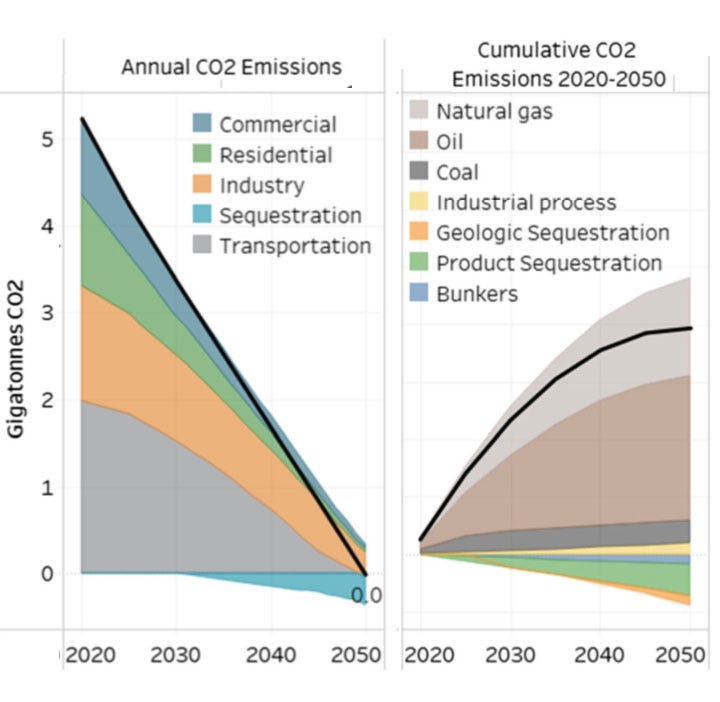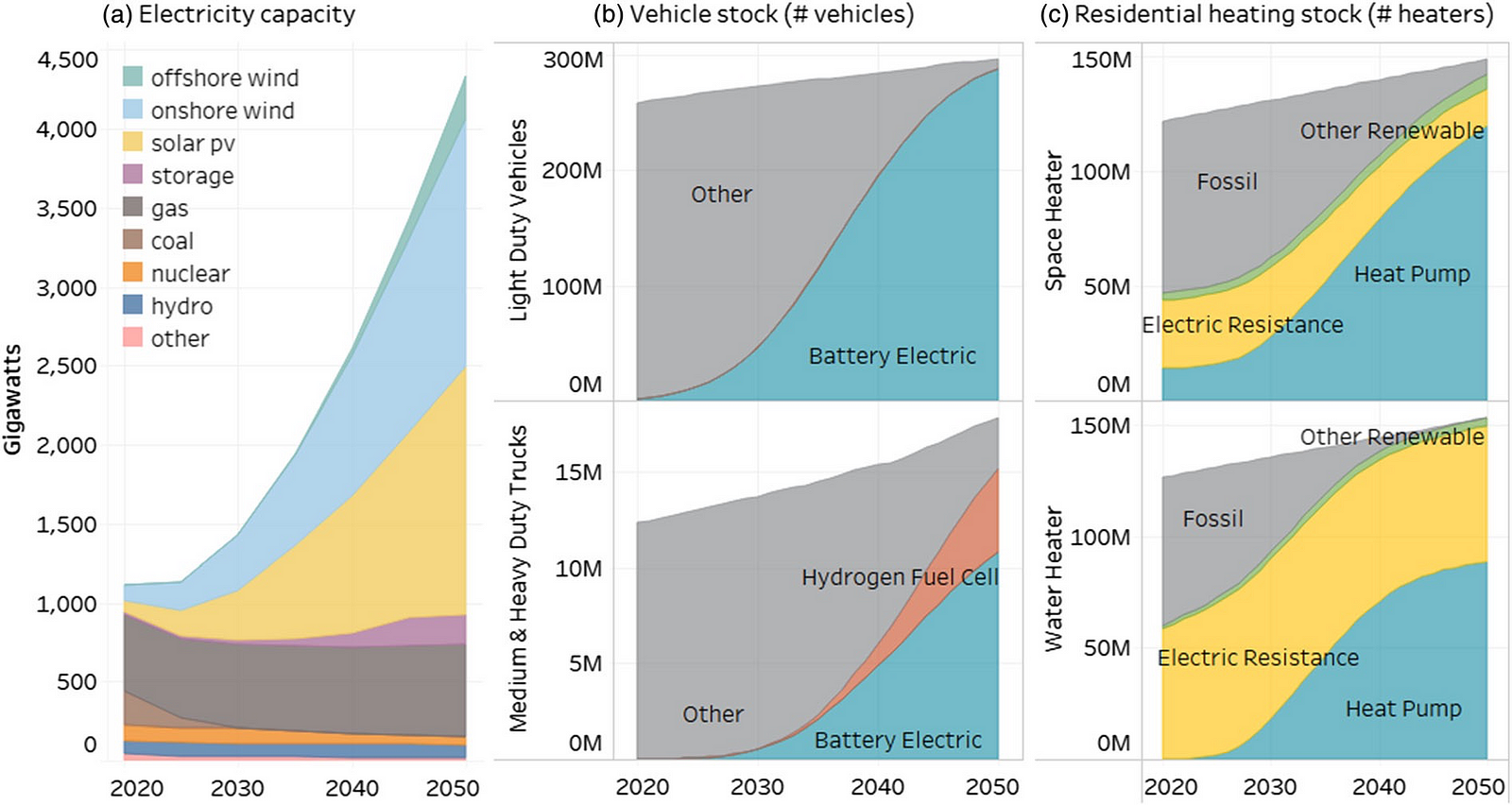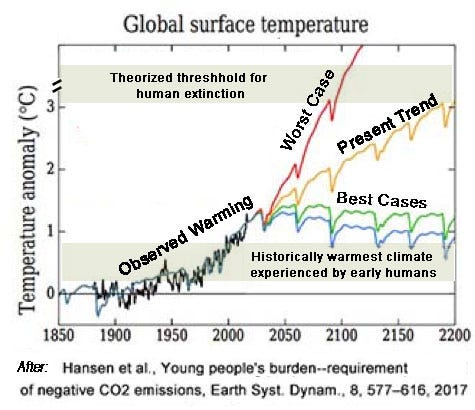The Great Pause Week 48: The Climate Cabinet
"What we need to do will cost less by one-third what we currently spend on fossil fuel subsidies."
A short while from now all of the President’s cabinet nominees will be confirmed and a first cabinet meeting will be convened. We’d like to imagine that after the usual banalities and formalities, it might go something like this.
PRESIDENT BIDEN: We face a great many challenges as a nation — the viral pandemic; an economy that will remain in dire straits for much of this year with consequences that will linger long after; serious security threats from both state and non-state actors — but what we are going to talk about now is the other emergency, the one that we can no longer ignore. I am going to turn the floor over to my climate advisor, Gina McCarthy.
MS. MCCARTHY: Thank you Mr. President. I will keep this as short as I can. Many of you have years of experience getting briefings like this, but what I am about to tell you may surprise you.
Let me begin with a few charts most of you will be familiar with. This first one is from James Hansen’s famous 2017 paper, “Young People’s Burden.”
I realize not everyone here is a climate science wonk, so let’s extract the most important takeaways this way:
The black line is the historical record of CO2 emissions from the start of the Industrial Age in 1850. The lower green line assumes that all the countries in the world achieve Net Zero CO2 emissions by 2050 and the blue line is if they accomplish that by 2040. In either of those cases, global temperature peaks at around 1.4C above normal and then declines to about 1 degree above and we achieve the goals of the Paris Agreement.
We can do this entirely by replacing fossil fuels with renewable energy, no geoengineering or negative emissions technologies required. The rollout and replacement will need to be very rapid. We have to retire existing coal plants and gasoline-powered vehicles and heavy equipment as rapidly as possible and replace all of it. That will look something like this:
 |
Williams et al, 2021 |
There is a limited role for fossil gas in the transition but we will need to be far more strict about fugitive emissions from drilling and pipelines, and gas will have to be also phased out by around 2040, just twenty years from now.
While these are all difficult tasks, they are things we know how to do. There is nothing that needs to be invented that doesn’t already exist. This is an affordable project — about $1 per person per day; less by one-third then we currently spend on fossil fuel subsidies — and it will make many new jobs and buoy our economy, almost immediately. By methodically increasing energy efficiency, switching to electric technologies, utilizing waste biomass, wind and solar power, and deploying a small amount of carbon capture technology such as BiCRS, the United States can reach zero emissions without requiring changes to behavior.
VICE-PRESIDENT HARRIS: I sense there is a “but” coming.
MS. MCCARTHY: I am afraid so, Madam Vice-President. The change to the atmosphere brought about by the picture I just painted is only short-lived. Here is another chart, that takes it out beyond 2100:
 |
Randers et al, 2020 |
What is going on here? If we wait until 2050 to make this change, and hit net-zero at 2100, you get the top line, in black. By assuming our technology is much better then, we get a rapid drop until about the second quarter of the next century. By then everyone is feeling much better about having solved the problem.
Then, suddenly, it changes and starts going back up, despite whatever anyone tries to do. The dotted purple line assumes we start right now and achieve net zero by 2050, but then the same thing starts to happen, within our own century. The curve rebounds and continues rising to 2.5 degrees and much higher in later centuries. It only gets worse. This is what sea level rise looks like:
 |
Randers et al, 2020 |
The left-hand chart is permafrost melt. That is baked into the cake now. It will only stop if we can get the atmospheric CO2 levels back to around 300 ppm. The middle chart is what melting ice cover and permafrost do to albedo, or the ability of sunlight to bounce back to space, reflected off of shiny surfaces. Naturally that goes down as we lose more ice and snow cover. The third chart is how all that is going to affect sea level rise. We are looking here at a 1 meter rise by 2100, if we wait to act, and 2200 if we act rapidly. But one meter is a fait accompli, and only the start of a much greater rise. So, what is going on?
What we are seeing here are the latent consequences of delayed action. Those who warned Lyndon Johnson in 1965 that we had 20 years to turn this around or told Jimmy Carter in 1977 that we had just 10 years left were precisely correct. Those who issued that same sort of warning in 1990, 2000, 2010, or 2020 were just gaslighting us.
After the short-lived greenhouse gases decay away, the long-lived ones keep gradually warming the planet. Greenland, the Arctic Ocean, and Antarctica continue to melt, less sunlight is reflected back to space, and sea levels continue rising. That process has been set in motion by tipping points that were crossed when we and most other countries failed to meet our Kyoto Treaty obligations more than 20 years ago. So, even if we now hit our Paris targets, we still have to face the fact we will likely lose large parts of Miami and New Orleans and will have to spend vast amounts of money to save New York City, Washington, Sacramento and many other coastal cities.
We can see how this happens if you compare our planned approach to lowering carbon emissions to zero and the actual effect that has on the atmosphere:
 |
Williams et al, 2021 |
The chart on the left is the Net Zero 2050 pathway of annual emissions for the US and the path on the right is that same pathway’s cumulative emissions. The chart on the left has its own challenges, as I will discuss in a minute. It is the chart on the right, however, that is going to cause the problem. Once we stop emitting greenhouses gases, the insulation of the atmosphere, and global temperature, will stop growing, but where we stop is where we stay.
Between 2020 and 2050 we expect to load the atmosphere with another 100 billion tons of greenhouse gases from the United States. Those will eventually go away. They will be absorbed by the ocean, space, or break down chemically. Unfortunately, that process does not take years, or even centuries. The natural drawdown process takes thousands of years.
MR. KERRY: I really hope this is not the whole story and you have something you are saving to tell us.
MS. MCCARTHY: Yes, John, thank you. There is. If, in addition to merely substituting clean energy for fossil energy we invest in a strong program of carbon dioxide removal, there is a 50–50 chance we can switch off that future and move into to a better one.
VICE-PRES. HARRIS: Not great odds.
MS. MCCARTHY: Not great odds. But better than zero. We already have good enough negative emission technology to achieve a large fraction of what we need at negative cost — that is to say, it produces profits — and with just that we can achieve 350 ppm by year 2100. By accelerating that development it is conceivable that we could return to pre-industrial concentrations by early in the next century, if not sooner. Below 300 ppm, ice would begin to reform at the poles. Ocean heat would stabilize and sea level rise would slow. That is the consensus science finding at this moment.
 |
| Bates, after IPCC 2021 |
You see going forward there is a large yellow and orange zone below zero, which is our carbon capture and net drawdown zone.
The “normal” temperature of our old climate, from about 200 to 250 years ago before widespread use of fossil fuels, could be recovered at 220 ppm, with about 90% confidence level. That, Mr. President and Mr. and Ms’s Secretaries, is our new target.
PRES. BIDEN: All good news.
MR. KERRY: All good news until you get to the politics. (laughter)
GENERAL AUSTIN: Politics will come down to guns or butter. I don’t know how you will sell this, given we're also asking for better cyber-defense and projecting fleet power into the South China Sea.
MS. MCCARTHY: Xi Jinping’s Green New Deal proposes $30 billion per year toward seven strategic goals: universal 5G cellular; artificial intelligence; industrial internet of things; data centers; EV charging stations; intercity high speed rail; and ultra high voltage smart grids. That sounds a lot like what we will be proposing, as will our NATO allies.
GEN. AUSTIN: I’m sorry, but are those guns or are those butter?
PRES. BIDEN: I would say the distinction has become irrelevant, Lloyd.
MS. MCCARTHY: I am afraid, Mr. President, the challenge is not technical, as I said at the start. Our challenge is a social and cultural one.
Here are some charts that show what we will need to do just on the clean energy transition to get to Net Zero 2050. First let me begin by showing what a growing economy like the United States will demand as we electrify our transportation, industry, and heating, and phase out fossil fuels.
 |
| Williams et al. 2021 |
The 21st century recarbonization, by moving strongly into electrification, will cost on the order of one trillion dollars and to that we must now add negative emissions technologies to bring us back below 250 ppm, assuming most other countries, and in particular Europe, China, Russia, and India, can be persuaded to do the same. The Fed is telling me our proposed capital investment in climate of $600B per year represents about 10% of current U.S. annual capital investment of $6T in all sectors, but remember — what we will actually be doing is redirecting some of the $800B/year from fossil fuels into clean energy and NET technologies. So, finance per se is not a barrier.
What I want everyone here to pay attention to is not the goal, but the direction of change and the speed at which it must be accomplished. It is how we get from here to there. If we miss the target by so much as a decade, the world winds up at 3 degrees, maybe more. Humans and nearly all other mammals, with the limitations of our sweat glands to cool our bodies, could go extinct at some yet unknown temperature. Our kind, going back several million years, has never lived above 3 degrees. So, that course is unthinkable. We must get onto this lower trajectory.
In many ways the transformation is going to be truly marvelous. We will see cargo ships built like the Americas Cup yachts, with hydrofoils and carbon fiber hulls. We will see wooden skyscrapers. Carbon will become a much greater part of our lives. It will be ubiquitous. Let me run this brief clip from climate scientist Michael Mann.
Video:
“The lockdown and social distancing — those weren’t really voluntary actions, we were forced to do that by the pandemic — and we saw that those did have an immediate impact: carbon emissions are going to be down about 7% this year. That’s the good news, right? We’re actually sort of coming down the ramp now, as we need to do. The bad news is we’ve got to do that 7%, roughly, every year. Seven percent upon seven percent, then seven percent more the year after that for ten years, if we are going to bring carbon emissions down fast enough to avert catastrophic warming of the planet — more than a degree and a half Celsius or roughly three degrees Fahrenheit warming. To do that, behavioral change simply isn’t going to be enough. We are going to need to decarbonize civilization; we need to decarbonize all the sectors of the modern economy. And that requires serious, systemic change, not just behavioral change. But we can do it.”
What does that mean in practical terms, for your average factory-worker, or office clerk, or someone teaching school or waiting tables? Let’s talk this through. If yours and my climate pollution footprint is 16 tons, as it is now, within a couple of years it needs to be 14 tons. A few years after that it needs to be 12. Well, in the EU it is 11.5 now and moving down. The global average is at 4. We know this is do-able.
The Danish government has told its people they have to get down to 2 tons per person and, you know what? Danes are listening and doing it. In Denmark 47 percent of the population considers climate change to be the most serious problem facing the world. That’s more than double the E.U. average of 23 percent.
I guess don’t have to tell you what pollsters tell us about the United States.
SECRETARY GRANHOLM: I guess I am not getting something here. If we can replace all our carbon emitting machines and factories with clean energy and also deploy negative emissions technology to deal with what is up there from the past, why does anyone have to modify their lifestyles?
MS. MCCARTHY: By 2050, global negative emissions technology will require a third to half of total biomass on the planet for conservation, sustainable bioenergy and carbon capture (up to 80 Gj in energy terms). That will only barely keep pace with population growth and rising standards of living around the world, and also pull down legacy emissions. If those of us in the developed world cannot bring our lifestyles into sync with our carbon limit we will blow out the budget nature has provided. It is a hard biophysical limit.
SECY. GRANHOLM: What about nuclear fission and eventually fusion instead of more bioenergy?
MS. MCCARTHY: Sorry, that doesn’t draw carbon out of the sky. We can and will build direct air capture machines, but those take energy, they don’t produce it. Only photosynthesis lets us have both. Also, there is no way we will replace a million acres of seagrass meadows or the Siberian forest with direct air capture machines.
PRES. BIDEN: Social acceptability is key to our success. We are going to have to sell this to the American people and I can already hear the howls from the other party. And you know what Bill Clinton said, “You can’t get elected by promising people less.” We all saw what happened when Jimmy Carter tried that.
Suggestions? Anyone?
_________
References
Canadell, Josep G., and E. Detlef Schulze. “Global potential of biospheric carbon management for — Second level climate mitigation.” Nature communications 5.1 (2014): 1–12.
Hansen, James, Makiko Sato, Pushker Kharecha, Karina von Schuckmann, David J. Beerling, Junji Cao, Shaun Marcott et al. “Young people’s burden: requirement of negative CO 2 emissions.” Earth System Dynamics 8, no. 3 (2017): 577–616.
Randers, Jorgen, and Ulrich Goluke, “An earth system model shows self-sustained melting of permafrost even if all man-made GHG emissions stop in 2020.” Scientific reports 10, no. 1 (2020): 1–9.
Sanchez, D.L., P.A. Turner, E. Baik, C.B. Field, S.M. Benson and K.J. Mach. “Rightsizing expectations for bioenergy with carbon capture and storage toward ambitious climate goals” in Bioenergy with Carbon Capture and Storage: Using Natural Resources for Sustainable Development, Elsevier Press (2019).
Sandalow, David, Roger Aines, Julio Friedmann, Colin McCormick and Daniel Sanchez, Roadmap: Biomass Carbon Removal and Storage (BiCRS), ICEF 2021.
Sivaram, Varun, Colin Cunliff, David Hart, Julio Friedmann, and David Sandalow. “Energizing America.” CGEP, Sept 2020.
Williams, J. H., Jones, R. A., Haley, B., Kwok, G., Hargreaves, J., Farbes, J., & Torn, M. S. (2021). Carbon‐neutral pathways for the United States. AGU Advances, 2, e2020AV000284.
________________________
As the world confronts the pandemic and emerges into recovery, there is growing recognition that the recovery must be a pathway to a new carbon economy, one that goes beyond zero emissions and runs the industrial carbon cycle backwards — taking CO2 from the atmosphere and ocean, turning it into coal and oil, and burying it in the ground. The triple bottom line of this new economy is antifragility, regeneration, and resilience.
Help me get my blog posted every week. All Patreon donations and Blogger subscriptions are needed and welcomed. My brief experiment with a new platform called SubscribeStar ended badly, with my judgement that they are not yet ready for prime time. You are how we make this happen. Your contributions are being made to Global Village Institute, a tax-deductible 501(c)(3) charity. PowerUp! donors on Patreon or SubscribeStar get an autographed book off each first press run. Please help if you can.
#RestorationGeneration
“There are the good tipping points, the tipping points in public consciousness when it comes to addressing this crisis, and I think we are very close to that.”
— Climate Scientist Michael Mann, January 13, 2021.






Comments